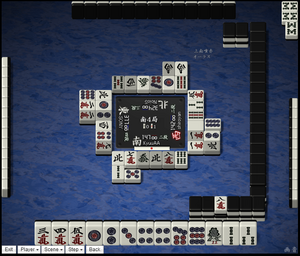Suji: Difference between revisions
m (→External links) |
m (→External links) |
||
| Line 11: | Line 11: | ||
== External links == | == External links == | ||
{{jpwiki|筋_(麻雀)}} | {{jpwiki|筋_(麻雀)}} | ||
{{Navbox strategy}} | |||
[[Category:Terminology]] | [[Category:Terminology]] | ||
[[Category:Strategy]] | [[Category:Strategy]] | ||
Revision as of 20:46, 29 September 2014

|

|

|

|

|

|

|

|

|
Suji 「筋」 is the principle of utilizing the "mahjong octaves". This applies to the numbered suits: souzu, pinzu, and manzu. While these three suits are numbered 1 through 9, the numbers may be arranged in a square fashion to determine the "octaves". The purpose is to deduce and/or determine tiles waiting via open waits.
Defense
Defending using suji essentially presumes a player to be utilizing either the wait pattern of ryanmen, ryanmenten, nobetan, sanmentan, or some other variation. Under the rule of furiten, if a player discarded a waiting tile, then the player's ability to call "ron" is disabled. Therefore, certain tile discards may rule out certain mahjong octaves.
Offense

The strategy of suji may be used offensively. By utilizing suji in reverse, a player may use a tile within an "octave" to lure out a winning tile along the same "octave". This is commonly known as the "suji" trap.
External links
- Suji in Japanese Wikipedia
| |||||||||||